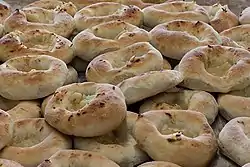Bialy (bread)
Bialy (Yiddish: ביאלי), a Yiddish word short for biały or bialystoker kuchen (Yiddish: ביאליסטאקער קוכען), from the city of Białystok in Poland,[1] is a small roll that is a traditional dish in the Polish Ashkenazi Jewish cuisine.
 | |
| Type | Bread |
|---|---|
| Course | Breakfast, Brunch |
| Place of origin | Poland |
| Region or state | Central Europe |
| Created by | Polish Jews |
| Main ingredients | Flour |
Overview

A traditional bialy has a diameter of up to 15 centimetres (5.9 in) and is a chewy yeast roll similar to a bagel. Unlike a bagel, which is boiled before baking, a bialy is simply baked, and instead of a hole in the middle it has a depression. Before baking, this depression is filled with diced onions and other ingredients, possibly including garlic, poppy seeds, or bread crumbs.[2]
Variations
The bialy was brought to the United States by Polish Jewish refugees in the late 1800s, and became a staple of Jewish bakeries in the Northeastern United States. Bialys became a popular bread and also breakfast for people in New York City, and the outlying areas; especially American Jews. Bialys are commonly baked by bakeries who also sell bagels, however there are differences between the two and the bialy has failed to reach the mainstream popularity the bagel has enjoyed in the United States, and indeed worldwide, for decades. Making bialys in the traditional manner is a time-consuming process, and thus many bakeries now make bialys with machines, as is common with bagels as well. Bialys are considered an iconic food representative of New York City, and can be difficult to find outside that area. However bialys are sold frozen by a number of brands such as Ray’s New York, and others, in supermarkets across the country.
In popular culture
In 2000, former New York Times food writer Mimi Sheraton wrote a book dedicated to the bialy and its role as a symbol of the Jewish heritage of Białystok, entitled The Bialy Eaters: The Story of a Bread and a Lost World.[3][4]
See also
- Kossar's Bialys, the oldest bialy bakery in the United States
- Cebularz and Pletzel, two similar breads
References
- "Bialys, cousins to the bagel, but without a hole". The Boston Globe. August 7, 2013. Retrieved 8 February 2018.
- "Bialy". Free Merriam-Webster Dictionary. Merriam-Webster. Retrieved 30 June 2014.
- Sheraton, Mimi (2000). The Bialy Eaters: The Story of a Bread and a Lost World. New York: Broadway Books. ISBN 9780767905022. OCLC 44039265. Bialy (bread) at Google Books (searchable).
- Parsons, Russ (December 17, 2000). "A Dimpled Bread". Los Angeles Times. Retrieved 2017-01-06.
External links
- Bialy recipe at Jewishfood-list.com